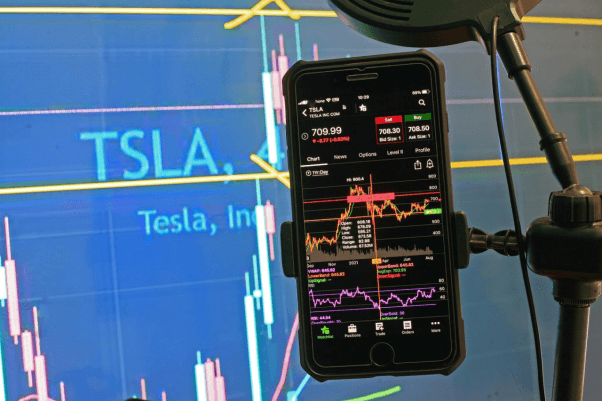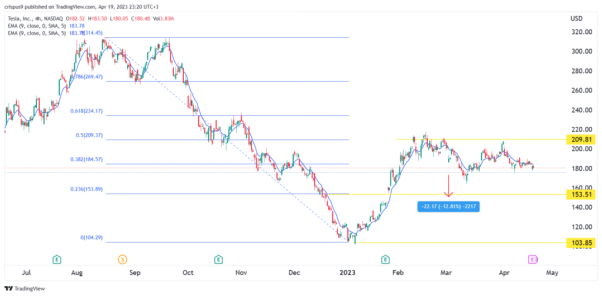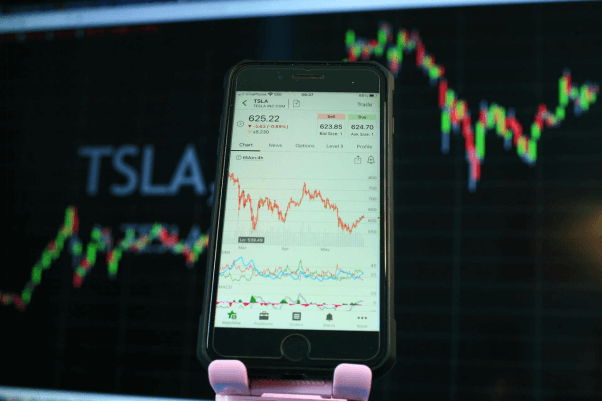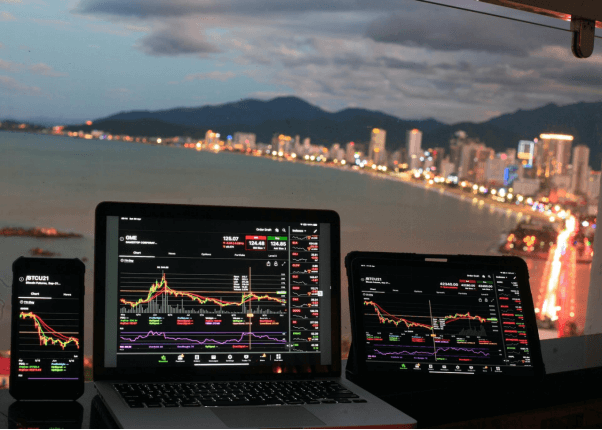Tesla lnc is an American electric vehicle and clean energy company founded by Elon Musk in 2003. It has revolutionized the automotive industry with its electric cars, batteries, and solar products, making it a highly talked-about company in the investment world. While investing in Tesla stock or CFDs can be a high-risk, high-reward opportunity, Tesla has attracted devoted investors who believe in its long-term growth prospects. It has a ticker symbol of nasdaq: tsla.
This article will examine the risks and rewards of trading/investing in Tsla stock and CFDs, analyzing the company's financials, the factors driving its growth, and potential risks that could impact its future performance. By the end of the article, readers will have answers to their questions, “Is Tesla Stock a Good Buy?”
Analysis of Tesla’s Financial Performance
Tesla’s Financial State
Tesla's revenue for Q1 2023 was $18.6 billion, up 50% from the previous year due to increased demand for vehicles and energy products. They reported a net income of $1.8 billion, a significant improvement from the net loss of $702 million in the same period last year. Tesla's gross profit margin was 26.5%, up from 22.5% in the previous year, and they delivered a record 222,000 vehicles in Q1 2023. However, Tesla also reported a net loss of $98 million due to a $1.7 billion Bitcoin impairment charge. Tesla's quarterly earnings per share were $4.02, exceeding analyst expectations.
Tesla's Sales Figures and Future Growth Potential
Tesla’s sales have experienced significant growth in recent years, primarily driven by the popularity of the Model 3, which became the world's best-selling EV in 2021. The Model Y has also seen strong demand, and the Model S and Model X remain popular among luxury car buyers. Tesla's expansion into new markets such as plans to boost its exports and explore new markets to accommodate the increasing competition. As a part of this strategy, the company has already initiated the transportation of vehicles to Thailand and established its inaugural Supercharger station in the country in February. Also, the continuous investment in research and development, such as battery and self-driving technology, demonstrates Tesla’s potential for further growth.

Comparison of Tesla's Financial Performance with Its Competitor
Tesla faces competition from various players in the automotive industry, including traditional automakers such as Ford and General Motors and new entrants like Rivian and Lucid Motors. Here is a comparison of Tesla's financial (Nasdaq) performance with some of its competitors:
Tesla Vs. Traditional Automakers
When comparing Tesla to traditional automakers such as GM and Ford, Tesla has a higher gross profit margin and market capitalization, despite GM and Ford having a larger revenue. This reflects Tesla's focus on higher-end electric vehicles and investor optimism about the company's growth potential.
Tesla Vs. New Entrants
In terms of market capitalization, Tesla is significantly higher than Rivian and Lucid Motors, reflecting its position as a more established player in the electric vehicle market. However, both Rivian and Lucid Motors have received significant investments and have ambitious plans for the future, indicating that they could become significant players in the electric vehicle market in the coming years.
Analysis of Tesla’s Position in the Market
Tesla’s Brand Awareness and Investor Sentiment
Tesla lnc is well-known among the general public, ranking as the top electric car brand in a recent YouGov survey with 48% of respondents. The company also has a strong social media presence, with over 1 million Twitter followers, over 5 million Instagram followers, and 1.5 million YouTube subscribers, indicating a large and engaged audience.
Investor sentiment refers to how investors feel about a company's stock. An optimistic view leads to higher prices, while negative sentiment can result in lower prices. Tesla stock is polarizing; some see it as a growth opportunity, and others as overvalued and risky. The stock has had significant volatility, with growth and declines. Stock price performance and analyst ratings are ways to gauge investor sentiment. Analyst ratings are mixed, with 9 "buy," 6 "hold," and 3 "sell" ratings, suggesting uncertainty about Tesla's future.
Comparison of Tesla's features and offerings with its competitors
● Battery Technology: Tesla's proprietary battery management system optimizes battery performance and extends battery life, making Tesla batteries the best in the industry with the highest energy density. Competitors like Rivian and Lucid Motors are developing their battery technology but still need to reach Tesla's level.
● Autopilot: Its Autopilot is the most advanced and capable suite of advanced driver-assistance features that allows the car to navigate, accelerate, and brake independently. Other automakers offer similar features, but Tesla Autopilot is widely considered the most advanced and capable.
● Charging Infrastructure: Its network of Superchargers and Destination Chargers offer fast and widely available charging options, while competitors like Rivian and Lucid Motors are still building their charging networks and offer a different level of coverage than Tesla.
● Design: Its sleek and futuristic designs are often praised and have cultural recognition and cache. While competitors like Rivian and Lucid Motors offer stylish designs, they have different recognition than Tesla's designs.
● Price: Tesla cars are generally priced higher than their competitors but offer high performance and features, which can justify the higher price tag for some buyers.
News and Events that Could Impact Tesla's Market Position
Various factors, including regulatory changes, supply chain disruptions, geopolitical tensions, and consumer sentiment, can influence Tesla's market position. For example, regulation changes, such as the EU's plan to ban petrol and diesel cars, could boost the market for electric vehicles, including Tesla's. On the other hand, supply chain disruptions, such as the global semiconductor shortage, can impact Tesla's production, costs, and supply chain risks. Geopolitical tensions, such as the US-China trade war, can increase tariffs on goods, including electric vehicles, and impact Tesla's operations in key markets. Finally, consumer sentiment towards electric vehicles and Tesla's business practices can impact the company's reputation and success, with negative events or news potentially affecting consumer sentiment. One recent example of news that potentially affected consumer sentiment towards Tesla was the fatal crash involving a Tesla Model S in Texas in April 2021. The car crashed into a tree and caught fire, and reports indicated that no one was in the driver's seat at the time of the accident. This raised concerns about the safety of Tesla's Autopilot system. Such incidents can potentially negatively impact consumer sentiment towards Tesla and electric vehicles, particularly regarding safety concerns.
Analysis of Tesla Stock Performance
Tesla Stock Price History
Tesla went public in 2010 at $17 per share, and its stock price has fluctuated significantly. The stock remained relatively stable between $20 and $30 per share until 2013, when it began to rise and reached around $100 per share by the end of the year. The following year, the stock skyrocketed to over $200 per share and by 2017, it was trading at over $300 per share. In 2020, Tesla stock saw a massive surge, reaching an all-time high of $900 in January 2021 before pulling back slightly. As of April 25, 2023, Tesla's stock price sells at $161.56.

However, Tesla stock price will likely continue to be volatile, depending on factors such as competition in the electric vehicle market, regulatory changes, and global economic conditions.
Brief Technical Analysis of Tesla Stock Performance in Recent Years
Tesla's stock has been affected by various factors, such as financial results, product introductions, market mood, and current events. Technical indicators like the Relative Strength Index (RSI) and Moving Average Convergence Divergence (MACD) can be employed to assess the direction and momentum of Tesla's share prices in the past few years.
RSI is a momentum metric that evaluates the rate and magnitude of price fluctuations on a 0 to 100 scale. Typically, an RSI above 70 signifies that the stock is overvalued and could be due for a downward adjustment, while an RSI below 30 implies that the stock is undervalued and might be due for an upward shift. Tesla's RSI has fluctuated between 30 and 70 in the past few years, indicating that the stock has been in a balanced state most of the time.
However, there were some periods when the RSI reached extreme levels of 86.27, signaling a possible overbought condition. Tesla's RSI was 35.31 as of April 25, 2023, suggesting that the stock was neither overvalued or undervalued.

MACD is a trend-oriented indicator illustrating the connection between two moving stock price averages. The MACD line is determined by subtracting the 26-period exponential moving average (EMA) from the 12-period EMA. The 9-period EMA of the MACD line serves as the signal line. A bullish crossover occurs when the MACD line moves above the signal line, implying a potential upward trend. A bearish crossover occurs when the MACD line falls below the signal line, suggesting a possible downward trend. Tesla MACD has experienced several crossovers in the past year, indicating that the stock has been in a dynamic and volatile trend. For example, there was a bullish crossover when the MACD line crossed above the signal line, followed by a strong upward movement of the stock price to an all-time high of $409.97 months later. As of April 25, 2023, Tesla's MACD was -6.18, and the signal line was -3.05, signifying a bearish crossover.
Tesla Stock Price Forecast for 2023
Analysts have differing opinions about the direction of Tesla stock price in 2023. Some analysts have downgraded the stock, while others have upgraded it, citing Tesla's strong market position and the expected increase in vehicle production. A survey conducted by MarketBeat among analysts revealed that the majority recommendation for Tsla stock was to hold.
The mean prediction for Tsla stock price over the next 12 months was $275.68, with a range of projections from $33.33 to $526.67 among the analysts. The daily chart shows that the Tesla stock price shows signs of weakness, with a double-top pattern at $209 and a neckline at $162. This pattern is typically seen as a bearish indicator, and the stock has fallen below the 25-day moving average and the 50% Fibonacci Retracement level.

The stock price may continue to decline in the near future, with sellers targeting the 23.6% Fibonacci Retracement level, which is roughly 12% below the current price. To confirm any potential upside, the bulls must push the stock price above the double-top point of $209.81. However, if the stock price drops below the 23.6% Fibonacci Retracement level, it could approach the year-to-date low of $103.
Is it Worth to Trade /Invest Tesla Stock and its CFDs?
Trading in Tesla stock and CFDs can offer high potential returns, diversification opportunities,and a forward-looking vision of a sustainable future. However, it also comes with significant risks, including high volatility, dependence on Elon Musk, regulatory and market risks. Conducting thorough research and analysis and having a well-defined risk management strategy to make informed investment decisions is essential.
If you are considering trading in Tesla stock or CFDs, there are several key considerations to keep in mind, such as:
Financial goals: You should clearly understand your financial goals and what you hope to achieve through trading Tesla stock or CFDs. Are you looking for long-term growth or short-term gains? What is your expected rate of return, and what is your investment timeframe?
Risk tolerance: Tesla is a high-risk, high-reward investment, and assessing your risk tolerance before investing is essential. You should be comfortable with the potential losses of trading Tesla stock or CFDs.
Market conditions: The stock market can be unpredictable, and it's important to understand the current market conditions before investing in Tesla. Is the market experiencing volatility or stability, and how might that impact Tesla's stock price? What is the overall economic outlook?

Company performance: You should research Tesla's financial performance, including its revenue, earnings, and growth projections. Analyzing the company's financial statements can help you determine its financial health and prospects.
Regulatory environment: Tesla is heavily reliant on government incentives and regulations. You should stay current on any changes or regulation updates impacting the company's performance.
Technical analysis: It's crucial to conduct a technical analysis of Tesla's stock chart to identify trends and potential entry and exit points.
Based on historical trends, there is a possibility that the Nasdaq: TSLA will continue to rise and provide good returns by the end of the year. This presents a favorable opportunity for investors to consider purchasing Tesla (TSLA -2.43%) shares, as the stock has already shown impressive gains in 2023 and appears to have further potential for growth.
How to Trade Tesla Stock and its CFDs
Tesla is one of the world's most exciting and innovative companies, and its stock has been a hot topic for investors and traders alike. If you're interested in trading or investing in Tesla stock or CFDs, here's what you need to know:

Holding Tesla Stock for the Long-Term
If you believe in Tesla's long-term prospects and growth potential, holding Tesla stock long-term could be a good option. When you buy Tesla stock, you become a part-owner of the company, which means you have the potential to receive dividends and voting rights.
Tesla is not currently paying dividends, but this could change as the company grows and matures. Additionally, owning Tesla stock allows you to vote on important company decisions, such as electing board members and approving mergers and acquisitions.
Trading Tesla Stock Options
If you're looking for more leverage and risk control, trading Tesla stock options could be a good choice. Options give you the right, but not the obligation, to buy or sell Tesla stock at a specific price (strike price) before a specific date (expiration date).
Options can be a powerful tool for traders because they offer the potential for high leverage and the ability to control risk. For example, you could use options to limit your potential losses if Tesla's stock price were to drop.
Trading Tesla CFDs

If you're looking for a low-cost entry point and high leverage, then trading Tesla CFDs could be a good option. CFDs (contracts for difference) allow traders to speculate on the price movements of Tesla stock without actually owning the stock. CFDs can offer a wide range of trading instruments, including leverage, short selling, and stop-loss orders.
How to Short Tesla Stock
Short selling is a trading strategy where an investor borrows shares of stock from a broker and sells them in the market, hoping to buy them back at a lower price and make a profit. This is done using an equity margin account, where the borrowed shares serve as collateral. If the stock price falls, the short seller can purchase the shares at a lower cost, return them to the broker, and earn a profit. However, there are interest charges on the borrowed funds, which can impact the overall profit.
Why Trade Tesla Stock CFD with VSTAR?
VSTAR is a reputable online trading platform and one of the best Tesla CFD brokers. It offers CFD trading services on various instruments, including Tsla stock CFDs. Trading Tesla stock CFD with VSTAR can provide several advantages for traders. Here are some reasons why traders may choose to trade Tesla stock CFD with VSTAR:
Low Trading Costs: VSTAR offers competitive trading fees and low spreads on Tesla stock CFDs. This can help traders reduce their trading costs and maximize their potential profits.
Access to Global Markets: VSTAR is a global online trading platform that offers access to a range of markets, including the US market, where Tesla is listed. This means traders can trade Tsla stock CFDs from anywhere and take advantage of global market trends.
Risk Management: VSTAR offers traders several risk management tools, including stop-loss orders, which can help limit potential losses. Additionally, VSTAR provides negative balance protection, which means traders cannot lose more than their account balance.
Leverage: VSTAR offers flexible leverage for Tesla CFD trading, which can increase potential profits. But, traders should also know that leverage can amplify losses.
Range of Trading Tools: VSTAR offers traders a variety of tools and resources, such as technical analysis tools, market news, and economic calendars, which aid in making informed trading decisions and staying current with market developments.
Conclusion
Investing in Tesla is high-risk, with high rewards. Its rapid growth and innovative technology attract investors, but there are significant risks to consider, such as volatility, regulatory changes, and competition. Before investing, carefully weigh potential rewards against these risks, diversify your portfolio, and develop sound Tesla stock investment strategies based on your financial goals and risk tolerance.




